North American least shrew facts for kids
Quick facts for kids North American least shrew |
|
|---|---|
 |
|
| Conservation status | |
| Scientific classification | |
| Genus: |
Cryptotis
|
| Species: |
parva
|
 |
|
| North American least shrew range | |
The North American least shrew (Cryptotis parva) is one of the smallest mammals. It grows to be only about 3 inches long. This tiny creature has a long, pointed nose and a short tail. Its fur is usually grayish-brown or reddish-brown with a white belly. The fur gets lighter in summer and darker in winter.
Even though they look a bit like rodents (like mice), shrews are actually in a different animal group. They belong to the order Eulipotyphla. The North American least shrew has very small eyes and its ears are hidden in its fur. This means it doesn't see or hear very well.
Contents
Where Least Shrews Live
You can find the North American least shrew in many places. They live in grasslands from southern Canada all the way through the eastern and central United States and Mexico. In Canada, only a small group has been found in Long Point, Ontario.
These shrews mostly like to live in wet areas. This includes grassy fields, marshes, and meadows. While most shrews prefer wet places, the least shrew can also live in drier, higher areas. They are often found in fields and weedy spots. These places have lots of insects, which are their main food.
How Least Shrews Behave
This tiny shrew is active throughout the day and night. However, it is most active when it's dark. The North American least shrew hunts using its excellent sense of smell and touch. It digs through loose soil and fallen leaves to find its prey. It can also tunnel through moist soil, much like moles do, to search for food. But usually, it uses burrows that other animals have already made.
What Least Shrews Eat
The least shrew mainly eats small creatures without backbones. These include caterpillars, beetle larvae, earthworms, centipedes, slugs, and sow bugs. They will also eat parts of dead animals. Sometimes, they munch on small amounts of seeds or fruits.
This shrew often eats its prey whole. But when it catches crickets or grasshoppers, it bites off their heads. Then, it only eats the insides. If it fights a bigger animal, it aims for the legs to try and slow it down. If it bites a lizard, which is often too big to kill, the lizard's tail might fall off. This gives the shrew a meal while the lizard escapes. North American least shrews sometimes even live inside beehives and eat the baby bees. They often share their food with other shrews. These shrews eat more than their own body weight every day! They are also known to store food for later.
Least Shrew Homes and Social Life
North American least shrews make their homes in burrows. They also use shallow tunnels under flat stones or fallen logs. Their burrows are about 1 inch wide and can be from 10 inches to 5 feet long. They are usually not more than 8 inches deep.
Most shrews are not friendly with each other. But the North American least shrew is a social animal. They often work together to dig their burrows. They also frequently sleep together. From 2 to 31 shrews might live together at one time. This is more common in winter when they huddle together to stay warm.
Least Shrew Reproduction and Life Cycle
Female shrews line their burrows with leaves and grass to make nests for their babies. The breeding season for these shrews lasts from early March to late November. Females have two or more groups of babies each season. Each group usually has about three to six young.
When they are born, baby shrews weigh only about 0.3 grams. They grow very quickly! They reach adult size in about one month. Newborn shrews are deaf, blind, and have no fur. At 14 days old, their eyes open and they start to grow fur. By day 21, they weigh 4-5 grams, and they begin to eat solid food. The North American least shrew rarely lives for more than a year.
Who Hunts Least Shrews?
Natural predators of the North American least shrew include owls, hawks, the red fox, the raccoon, skunks, and snakes. The North American least shrew tries to defend itself by using its venomous saliva.
Threats to Least Shrews
The North American least shrew is considered an endangered animal in Connecticut. The biggest danger to them is when their coastal homes, especially dunes and marshes, are developed by humans.
- The Mammals of Texas Revised Edition by David J. Schmidly
See also
 In Spanish: Musaraña orejillas mínima para niños
In Spanish: Musaraña orejillas mínima para niños


